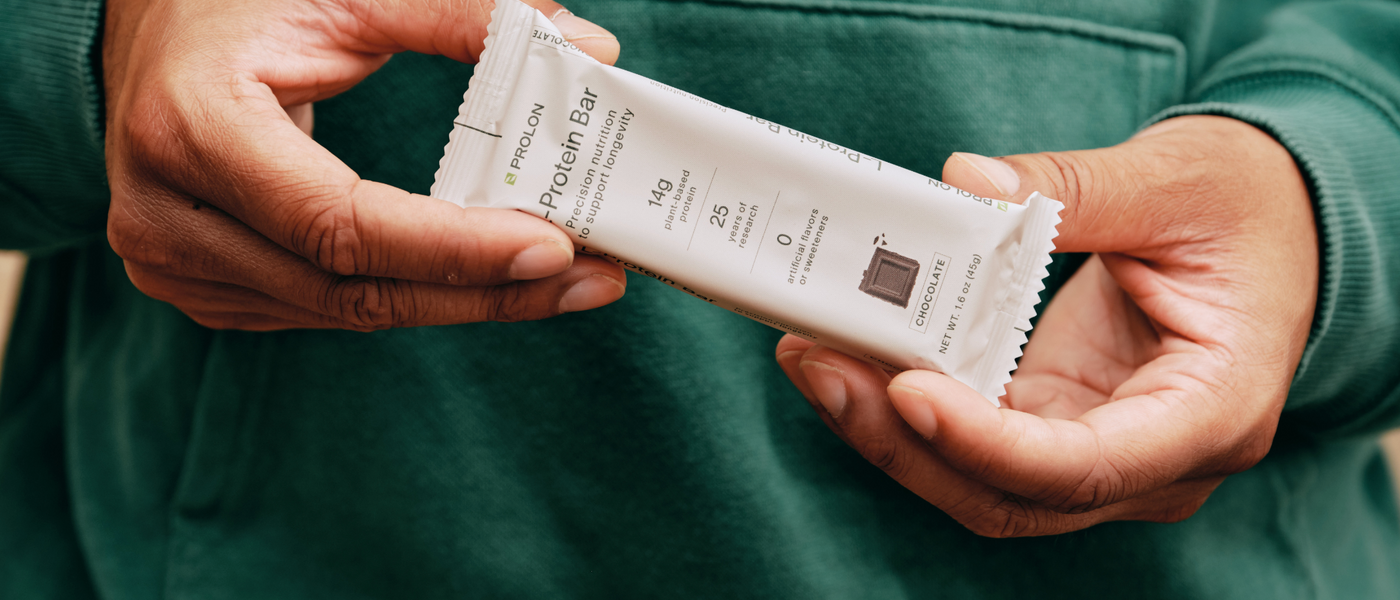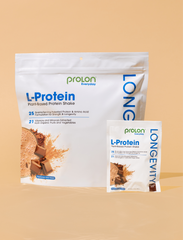
What To Look for in a Healthy Protein Bar (Spoiler: the One You’re Eating Could Be Aging You)
Key takeaways:
-
Protein bars can be a great snack, meal replacement, or post-workout recovery option, but may be hiding ingredients that could be harmful.
-
It’s important to know what to look for in your protein bar’s nutrition facts, and ingredients to avoid.
-
Animal-based protein sources are more likely to accelerate the body’s pro-aging pathways, while many plant-based proteins lack the essential amino acids needed to form a complete protein.
-
A diverse blend of plant-based protein that’s also fortified with L-Methionine for amino acid support can support muscle mass, as well as longevity.
-
The L-Protein Bar is the first protein bar designed to support both longevity and muscle health.
Protein is essential to nearly every function in your body. It helps build muscle, supports your immune system, fuels metabolism, and keeps your skin, hair, and organs healthy, among thousands of other functions. And in recent years, the market has exploded with bars, powders, and snacks promising to help you meet your protein needs.
With so many bars crowding the shelves labeled “clean,” “keto,” “plant-based,” “high-protein,” or all of the above, it’s easy to assume they’re all good for you. However, many are packed with hidden sugars, artificial ingredients, and protein sources that may do more harm than good when it comes to your long-term health.
Whether you’re snacking, recovering post-workout, or replacing a meal, it’s important to know whether your bar is actually supporting your health goals—or silently sabotaging them.
That’s why we created the Prolon L-Protein Bar. Backed by decades of research in longevity nutrition, it’s formulated to deliver clean, plant-based protein in a way that supports strength and healthspan—without over-triggering pro-aging pathways.
In this guide, we’ll explore what goes into protein bars, what to look for in a truly healthy one—and how the L-Protein Bar stacks up.
Start with the nutrition label
A quick look at the nutrition facts on a protein bar’s label can tell you a lot. Here’s what to look for:
Protein: Your protein needs vary based on your body size, activity level, and overall diet, but a helpful guideline is to look for bars made up of around 30% protein by total weight (for example, a 50g bar should contain about 15g of protein). Excess protein, especially from animal sources, can overstimulate growth factors linked to accelerated aging. Too little protein, on the other hand, may also be harmful. Post-workout, your body may need more protein, but quality matters more than quantity. The L-Protein Bar delivers 14g of high-quality, plant-based protein in a bar weighing approximately 45g—making it one of the most efficient plant-based bars on the market in terms of protein density.
According to longevity dietitian Melanie Murphy Richter, MS, RDN, “Protein is essential, no question. We need enough of it to maintain our muscle mass, support bone strength, and help our bodies repair and rebuild every single day. But more isn’t always better. When we consistently overshoot our needs—especially with animal-based protein—we can overstimulate growth factors like IGF-1, which are linked to faster aging and chronic disease risk." On the flip side, she says, "too little protein can lead to muscle loss, weakness, and poor metabolic function. The goal isn’t high or low, it’s optimal. And finding that sweet spot is one of the most important things we can do to support long-term health and resilience.”
Added sugar: If sugar in any form—such as cane sugar, high fructose corn syrup, maltose, or dextrose—appears among a protein bar’s first few ingredients, it’s a red flag. Keep added sugar low, ideally under 5g. Unlike total sugar, added sugar refers only to sugars added during processing—including syrups, inverts, and other distilled forms—not natural sources like fruit. For example, bars sweetened with whole dates may show higher total sugar but contain little to no added sugar. Dates are not only a natural, unprocessed sweetener but also have a lower glycemic impact and are generally easier for the body to absorb and process. The L-Protein Bar is naturally sweetened with dates and contains zero added sugars—making it a smart choice for clean, balanced energy.
Fiber: Fiber plays a critical role in health—it helps you feel full, supports digestion, promotes a healthy gut microbiome, and slows the absorption of sugar to support glucose regulation. Experts recommend aiming for at least 25–30g of fiber per day, yet most people fall far short. Look for bars with at least 3g of fiber per serving, ideally from whole plant sources like legumes, fruit, and nuts. The L-Protein Bar delivers 8g of fiber per bar—nearly 30% of your daily needs, and all from real, plant-based ingredients like chickpeas, dates, and black beans.
Calories: Many protein bars are surprisingly high in calories, even those marketed for weight management. If you're using a bar as a light snack, aim for 150–250 calories, with meal replacement bars providing a higher calorie count; it does, however, depend on your body size, goals, and activity level. The L-Protein Bar delivers just 170 nutrient-dense calories.
“It’s possible that the protein you’re consuming is causing you to age prematurely.”
— Dr. Joseph Antoun, MD, PhD, L-Nutra CEO
Know your protein source
Protein quality is critical, and not all sources are created equal.
-
Prioritize plant-based over animal-based protein: Animal proteins like whey and dairy may support muscle growth and maintenance, but when consumed frequently or in large amounts, they may overstimulate IGF-1 and mTOR, nutrient-sensing pathways linked to accelerated aging and chronic disease. While occasional consumption of animal protein can be part of a balanced diet (and is optional in the Longevity Diet a few times per month), relying on it as a primary protein source may not support long-term health and longevity. Choosing more plant-based options, especially in packaged foods like bars, is a smarter daily choice for those looking to support healthy aging.
-
Be mindful of processed soy: Soy is a plant-based protein and can be part of a healthy diet. However, the soy commonly used in processed foods is often highly refined, which may reduce its nutritional value and the chemicals used to process it may contribute to unwanted additives. Soy is also one of the most common allergens and, in some cases, may interact with certain medications or affect hormone-sensitive individuals. When including soy in your diet, aim for whole or minimally processed forms and be mindful of how much you’re consuming.
-
Choose diverse plant-based blends:The majority of plant-based proteins do not have a complete amino acid profile and must be paired with other foods to ensure you receive all essential amino acids. The L-Protein Bar uses black beans, chickpeas, peas, and more, and is fortified with L-Methionine—an essential amino acid often limited in plant-based diets—to ensure a complete amino acid profile that supports strength, recovery, and longevity.
Examine the sweeteners
Sweeteners can make or break a bar’s health benefits. The L-Protein Bar uses only whole dates, with no sugar alcohols or artificial ingredients.
-
Natural sugars (like dates or fruit) offer fiber and nutrients while minimizing blood sugar spikes.
-
Artificial sweeteners (like aspartame and sucralose) are linked to a range of health concerns and can backfire by actually increasing sugar cravings.
-
Sugar alcohols (including erythritol and xylitol) may cause digestive distress and, in excess, have been linked to cardiovascular risks.
Skip the fillers—even the hidden ones
Not everything in your protein bar actually is necessarily on the label, which can make spotting additives difficult.
-
Most protein bars contain hidden additives: Fillers like silicon dioxide (silica), maltodextrin, cornstarch, and cellulose are often used to improve texture or shelf life, but they offer little to no nutritional benefit, and may contribute to inflammation, digestive issues, or long-term gut damage.
-
In the U.S., if an ingredient makes up less than 2% of the product, it’s not required to appear on the label. That means your “clean” bar may still contain potentially harmful ingredients, and you’d never know.
-
Trust (and track record) matters. With over 25 years of using science to support healthspan, we’ve earned our reputation for helping people live healthier, longer lives. You deserve full transparency around what you’re putting in your body—and everything that’s in the L-Protein Bar is on the label. There are no hidden fillers or mystery ingredients. Our bar is clean, plant-based, whole-food protein you can recognize and trust.
“When we set out to produce L-Protein, we could not find a single supplier in the U.S. that did not add at least one extra ingredient like silica. After almost two years, we finally found a manufacturer who would make it 100% clean, and L-Protein was born.” - Dr. Joseph Antoun, MD, PhD, L-Nutra CEO
L-Protein Bar: built for more than just short-term gains
Most protein bars are designed for quick fixes, post-workout recovery, or temporary energy, or muscle gain. But many rely on incomplete proteins or ones that overstimulate age-accelerating pathways like IGF-1 and mTOR, key drivers of cell growth.
We created the L-Protein Bar to provide an alternative. Backed by 25 years of research led by Dr. Valter Longo, based on principles of the Longevity Diet (modeled after eating habits of populations with the highest number of centenarians), and developed in collaboration with researchers at the USC Longevity Institute and the IFOM Cancer Research Center in Italy, the L-Protein Bar isn’t just a quick snack—it’s longevity protein.
Formulated with high-quality, plant-based ingredients like black beans, chickpeas, peas, dates, and extra virgin olive oil, it offers:
-
A complete amino acid profile without overstimulating IGF-1 or mTOR
-
Clean nutrition with no soy, gluten, dairy, fillers, GMOs, or artificial sweeteners
-
Naturally sweetened from whole dates—no added sugar or sugar alcohols
-
Balanced macros to support energy, muscle, metabolism, and healthy aging
Your protein bar shouldn’t just fuel your next workout—it should fuel your future! Learn more here.
Sources:
Canadian Medical Association Journal. “Nonnutritive sweeteners and cardiometabolic health: a systematic review and meta-analysis of randomized controlled trials and prospective cohort studies.” Website.
Cleveland Clinic. “What You Should Know About Sugar Alcohols.” Website.
National Center for Complementary and Integrative Health. “Soy.” Website.
National Library Of Medicine. National Center For Biotechnology Information. “Aspartame—True or False? Narrative Review of Safety Analysis of General Use in Products.” Website.
National Library Of Medicine. National Center For Biotechnology Information. “Exercise, Dietary Protein, and Combined Effect on IGF-1.” Website.
National Library Of Medicine. National Center For Biotechnology Information. “High protein high fibre snack bars reduce food intake and improve short term glucose and insulin profiles compared with high fat snack bars.” Website.
Science Direct. “Oral intake of silica nanoparticles exacerbates intestinal inflammation.” Website.
Science Direct. “Understanding the role of NLRP3-mediated pyroptosis in allergic rhinitis: A review.” Website.














